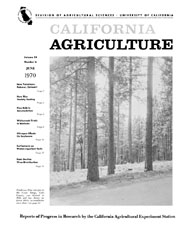


University of California
California Agriculture
|
|||
|
|||

Cover:
Ponderosu Pine test plot in the Coast Range, Lake County, was thinned in 1952 and has shown no forest debris accumulation since then.
June 1970
Volume 24, Number 6 |
|||
|
University of California, 1301 S. 46th St., Bldg. 478 Richmond, CA
|